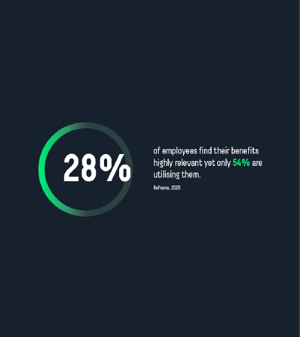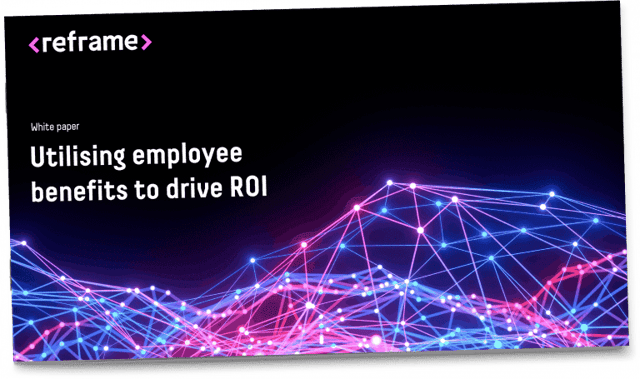.jpg?width=575&name=image%20(21).jpg)
Employee benefits
A guide to utilising employee benefits to improve effectiveness for employee wellbeing
What are employee benefits?
Employee benefits are perks or incentives that employers provide in addition to an employee’s salary. Examples include paid holiday, health insurance, cycle to work scheme or shopping vouchers.
These benefits are an integral part of a company’s employee value proposition, designed to attract and retain talent, promote employee engagement, and contribute towards improving employee wellbeing.
What are the 4 types of employee benefits?
- Core funded benefits – These benefits are paid for by the employer and employees cannot opt out.
- Flexible benefits – These benefits are paid for by the employer and employees can opt in and out when they choose.
- Voluntary benefits – These benefits are discounted from the supplier and paid for by an employee’s net salary.
- Salary sacrifice – These benefits are paid for directly through the employee’s salary and achieve tax and national insurance savings.
What impact has COVID had on employee benefits?
The pandemic has shifted the type of benefits and support required by employees and how they are delivered. As a result, the industry has seen a disconnect between employee needs and the benefits being offered by employers.
There is a greater demand for financial wellbeing programmes, mental health support and health-related benefits, while paid holiday, gym memberships and pensions have decreased in utilisation since the first lockdown.
Employee benefits have enabled employers to support employee wellbeing during these uncertain times. Many organisations have had to adapt their benefits design to accommodate remote working.
This has implications both for communications about employee benefits and for access to those benefits.
.jpg?width=300&name=image%20(22).jpg)
What benefits are most important to employees
There is no one-size-fits-all employee benefits package. Your programme should reflect the unique individuals that make up your workforce.
A key way to do this is to listen to your employees and avoid copying your competitors or being swayed by the most trendy benefits. Employees want benefits that are highly flexible and personalised to their needs — needs that are constantly changing.
Our research revealed that only 54% of employees are utilising their benefits. If your benefits scheme is not relevant to or valued by your employees, it will be costing your organisation rather than delivering a healthy return on investment.
An employee benefits scheme that’s right for your workforce will deliver employee satisfaction and help you to retain your top talent. As a result, you will maximise the value from your benefits on your payroll costs, reinforce your employee value proposition and reduce recruitment and HR costs.

Why are employee benefits important to employees?
Salary is not always the main consideration for employees when job hunting. Almost two in three employees admit that benefits are an important factor when applying for a new job.
An employee benefits scheme also gives future employees an insight into the organisation. Your offer should reflect brand values and demonstrate that the organisation genuinely cares about workplace culture, happiness and employee wellbeing.
Benefits are important to employees because they provide tax savings, access to services at a reduced rate and other free perks. Glassdoor found that nearly 80% of employees would choose an enhanced benefits package over a pay rise, which demonstrates the impact that benefits could have on recruitment and engagement strategies.
How to design an employee benefits scheme?
Designing an effective employee benefits scheme begins with your employees. Try to avoid simply offering a catalogue of benefits for them to choose from. Ask your team for feedback, understand their needs, and use these insights to tailor your benefits design.
Worryingly, employee benefits consultants, Aon, revealed that a third of employers do not use initiatives to understand the needs of their workforce.
It’s key that you regularly review your benefits design and encourage staff feedback to keep in touch with employees’ evolving needs and ultimately ensure your benefits remain relevant and utilised. It’s not the number of benefits you offer that’s important, but the quality of your overall scheme.
Providing a holistic, all-encompassing employee benefits scheme will increase your ability to support every aspect of employees’ lives, including their social, mental, physical, and financial needs. Your scheme should also reflect your diversity and inclusion strategy. The best employee benefits packages are inclusive and available to all, rather than appealing only to certain parts of the workforce.
The easier you make accessing and navigating your benefits, the better employee engagement you’ll see. Consider where you can coordinate or connect benefits to ensure an efficient and seamless experience.
.jpg?width=300&name=image%20(23).jpg)
How to attract employees with benefits?
Employees are looking for holistic benefit schemes that meet their needs and reflect their lifestyle. They need to be easy to access and well communicated.
While your benefits must satisfy your current workforce, they should also appeal to the diverse talent that you will need to attract in the future. Review your benefits scheme — is it relevant and competitive when accessing non-traditional talent pools or targeting a different skill set?
Where talent is in high demand, the importance of employee benefits is greater. Without an enticing and competitive benefits offering, how can you attract top talent?
Modernise your employee value proposition and offer a progressive employee benefits scheme to demonstrate that you listen and understand what your current and future workforce needs.
.jpg?width=300&name=image%20(24).jpg)
How can you improve your employee benefits?
Employee benefits should evolve with employee demand. Recognise when external factors have impacted your workforce and assess how you can support them by adapting your benefits design.
Identify if there are gaps in your benefits scheme. Does it support the different home and work-life stages of your employees? Every team member will have unique needs. For example, this might be one person’s first job, another might be expecting a baby, be eager to secure a promotion or be planning to retire.
Before you can measure the level of engagement with your benefits, you need to determine if your workforce is aware of the benefits available to them.
Enhancing communications can drive improvements. Consider the frequency and diversity of your initiatives — what works for some won’t work for others. If your organisation has a long menu of benefits for employees to choose from, helping them to select the right ones based on their needs will boost engagement.
Employee benefits schemes should be regularly reviewed and updated to ensure they remain relevant to and valued by employees. If your employees understand their benefits, value them and are proactive about using them, you will achieve a greater return from your benefits spend.

How can employee benefits schemes support employee wellbeing?
Employee benefits schemes can help change behaviours and incentivise employees to improve their health and wellbeing. By reducing staff burnout and sickness absence, you will have a happier, more engaged workforce.
An integrated approach is key to success. Feed your wellbeing strategy into your benefits design and vice versa — use a particular benefit to encourage a wellbeing initiative.
We have found whole-life balance, family-friendly, lifestyle-oriented and prevention-focused benefits — such as fertility funding, menopause support or a life coach — are increasingly desirable among today’s workforce.
We are living a more digital lifestyle and employees expect this reflected in the way they access and experience their benefits. Technology has become undeniably popular as a way to manage health and wellbeing in one place.
.jpg?width=300&name=image%20(25).jpg)
How can Reframe help with employee benefits?
Our digital health solutions help organisations develop a more resilient workforce, improve their talent proposition and build a business advantage. We work with employee benefit consultants, insurance providers and healthcare providers to deliver a personalised and connected solution.
Our experts understand how the demands of the workforce are changing — both through individual preference and trends and through more significant influences such as the pandemic and the use of technology in creating tailored personal experiences.
We equip individuals with the skills, confidence and knowledge to self-manage their wellbeing. Helping your people to overcome the impact cancer by understanding their unique challenges and providing a personal and nuanced response.
Contact us to find out more about how Reframe can help you to offer an employee benefits scheme that provides the support your people need. Our expert team will be happy to answer your questions or provide a quote.
.jpg?width=300&name=image%20(26).jpg)

Like to know more? Download our white paper: Utilising employee benefits to drive ROI
Insights
View our latest insights and stories


.jpg)
